Reflections of the 2015 Millionaire Chess Open


Nearly three weeks after the Millionaire Chess Open ended, there has been suspense when and where the third edition will be. Amy Lee revealed in her recent reflections piece and the challenges faced by the MC franchise. In addition, she sent out a survey looking at the feasibility of a third addition. One of the recent developments that came out of the reflections piece is the pursuit of sponsorship.
Most will understand that the tournament in its current form is not sustainable, but what the MC organization has built is something that will set the tone for major tournaments in the U.S. The second edition has a few changes… both additions and subtractions. The most obvious addition was the “Millionaire Chess Square” $1,000,000 prize. There was also a restructuring of the prize fund and changing of the time control. On the fun side a pool party and video contest! Event photographer David Llada took some nice photos of the pool party.
The tournament maintained its sophisticated decorum from last year with the gallantry of purple around the tournament site. The breakfast was an opportunity to network and socialize prior to the tournament and Maurice Ashley was in his element. To the surprise of many, Fabiano Caruana was freely mingling with the rest of the players. It is always good to see familiar faces at tournaments, but most notably the international players. Many were in the U.S. for the first time and their first impression was Las Vegas.
African qualifiers at Millionaire Chess… Wanyama (UGA), Oatlhotse (BOT), Olape (NGR). #MC2 pic.twitter.com/tpiMm80rXh
— Daaim Shabazz (@thechessdrum) October 8, 2015
There was the red carpet photos which were again a smash hit. Everyone came dressed with their own definition of “swagger” and some had creative poses. There was even a “lion attack” pose. In addition, there were more women and they were making quite an impression! Perhaps Millionaire Chess Open has started a welcome trend.

Was there a beauty pageant happening at MC2? No… these are chess players!
Photo by David Llada.
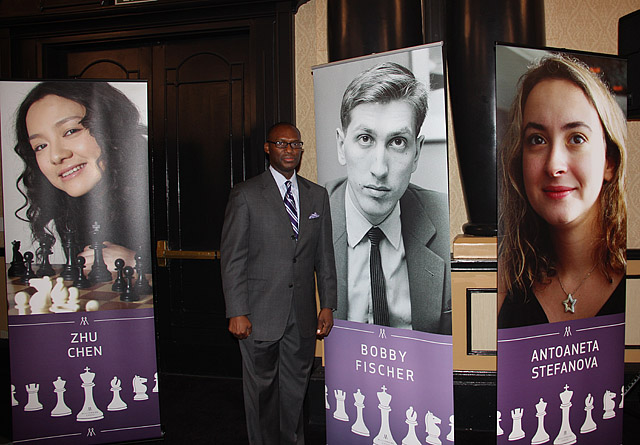
Bobby Fischer is favorite my player in history. Someone told me he knew of The Chess Drum. Somehow my other favorite player Judit Polgar deserves a place on this Wall of Fame.
Now the tournament would begin with all the stars shining… Hikaru Nakamura, Fabiano Caruana and Wesley So leading the charging with sharks like Yu Yangyi contesting. Wang Hao withdrew due to visas issues. In fact, there were players who withdrew to partake in the World Rapid and Blitz Championships.
CLICK to see larger images. Hover to get descriptions.
All photos by Daaim Shabazz (unless otherwise stated).
The first round got off to a cracking start after announcements and national anthem. Immediately there were upsets, a theme common in high stakes tournaments. FM Vignesh Panchanathan upset GM Varuzhan Akobian. It was a bad omen for Akobian who had prior to the round complained that the pairings were incorrect and he was seeded one place lower.
Unfortunately, there were some snafus in the pairings that did not take into consideration the withdrawals. The first round was challenging as several players were not paired and the website crashed. This was a inauspicious start for MC. After some feverish phone calls the website was restored and the broadcast thereafter was relatively stable.

Fabiano Caruana had a challenging start as FM Li Ruifeng trotted out the Evans Gambit and got a better position before accepting a draw. Sharks were circling and blood was in the water.

GM Evgeny Najer got nicked by IM Kassa Korley for 1/2 point.
While I was playing again this year, I was not able to catch the action on the top boards. It is indeed a difficult task to play and cover the event. This feat has cost me about 100 ELO points in the past year. In the first round, I played Sidi Boyin from Mauritania and missed several one-move wins in time pressure, then blundered into a lost ending. Sheesh.
In the last round, I let another winning position slip away, but at least it was interesting. However, the lesson is… do not play and cover tournaments. Another player Eduardo Franco told me this at the Southern Open in Florida after I missed a simple win against him at the Chicago Open. “Focus. No pictures,” he said. He’s right and here is proof.
Nevertheless, if one isn’t contending for Millionaire Monday, it may as well be fun. It appears that the elevation of the class players to the VIP section was a success. These players were able to mingle along with the professionals and may even have their games covered on the broadcast. There were jokes that GM Robert Hess made some of these players appear to be Grandmasters with the superlatives he was throwing at their games. Yet it was refreshing to see some of the games of the lower-rated section.
The tournament was still a success despite some of the problems that occurred and here are my personal reflections.
My five best memories were…
-
…playing a blitz session with FM Harold Wanyama. The Ugandan is one of the African players who appears frequently on The Chess Drum. To get to play him was quite a treat. We played an interesting set of blitz and the games were of decent quality (with a variety of openings). He won most of them. Some games I simply flagged. He was surprised and said, “You’re quite strong.” Well… not the force I used to be in blitz, but I started getting my form the more games we played. It is always funny to me when people assume I am not a tournament competitor, but merely a journalist who likes chess. 🙂 I suppose I need to share my games more… or stop being a journalist during tournaments (see comments and game above). Nevertheless, I enjoyed the opportunity to play Harold and he was quite the gentleman. We even had an nice interview. 15:03 minutes See you in Baku!
-
…seeing the Pan-African blitz battles! For nearly 15 years, I have covered chess in the African Diaspora and have met a number of the current players either through my visits to Africa or at the Olympiad tournaments I have covered. It is always interesting when players of the African Diaspora interact with each other. On occasion, they mingle and meet at Olympiad tournament, but Black players of North America typically do not have the opportunity to meet African and/or Caribbean players since many do not travel to North America to compete and players from America do not travel to Africa and Caribbean to play. It is generally a sense of intrigue and there are several blitz battles. IM Providence Oatlhotse 16:18 minutes was battling IM Kassa Korley and a spirited match. Nigerians are generally in the rotation as well. Mario Marshall of Jamaica was battling IM Bunmi Olape 12:46 minutes of Nigeria. Great fun!
-
…the confession booth. One of the year’s best innovations came to MC2. This was a big hit as dozens of players visited the booth over the five days. There were all types of creative and fun expressions, but some were simply reflections on their game in progress. I visited in rounds five and seven. Ahyan Uzzaman visited each day! There was a fun confession by Maurice Ashley and the other commentators. Unfurled at the Sinquefield Cup earlier this year where Maxime Vachier-Lagrave was the confessional king. This will certainly be a mainstay in future competitions.
-
…spending time with IM Kassa Korley. Kassa’s question to attend the MC2 was known to Jones Murphy who then relayed to me that we should make an effort to ensure he played. Kassa had graduated from Duke University and is charting the course for his next move in life. We figured out several options, but eventually we took advantage of the option to sign up another player and getting a free room. MC made this option possible. That basically meant that the money that I would have used to pay for my hotel for five days at Planet Hollywood would go toward Kassa’s entry fee… plus he’d be my roommate. Two problems solved. Both Jones and I collaborated to get the deal done and Kassa was ecstatic and grateful. Kassa is a talented player and worth the sacrifice to see him realize his talent. He is plain-spoken, very practical and a real as they come. It was a joy spending those days with him and we got to eat Ethiopian food as I promised! He particularly enjoyed meeting Malaku Lorne of Jamaica.

IM Kassa Korley (right) playing his friend FM Raven Sturt bullet chess. National Master Tyrell Harriott looks on.
-
…playing chess with Amy Lee! I met Amy for the first time last year at MC1 and since then we have become good friends. She is such an amazing person and we are blessed to have her involved with our sport.
While I was milling about in the lobby I stopped by the MC sales table and Amy excited said, “Let’s play. Let’s play.” Apparently she was challenging everyone. There was a catch you had to give 5:1. After the first disastrous game with me playing 1.e4 e5 2.Qh5, Amy began to catch on. She flagged me when I had mate in one and let out a laugh, “I survived!!!” Then she changed and we went to queen-odds. It was raucous and the onlookers loved it.

In my view, Amy playing blitz was one of my highlights of the event!
Very entertaining!Everyone was helping Amy… a queen up!! So a new rule was implemented that no one could help until after two minutes of her time expired. This brought some colorful exchanges, but mostly Amy was had so many advantages… since she’s so pretty, ambitious and helping our sport, everyone wanted to help her. 🙂 Amy would sometimes make an illegal move and hit the clock and you’d lose several seconds. Hooting and hollering would follow. It was so funny to see Amy gesticulate humorously over what move to make. I haven’t had so much fun in a long time playing blitz!

Amy left her king in check and I snapped it off! She grabbed my hand trying to get her king back. So funny! Had a blast playing Amy in chess!

Amy also challenged Maurice…
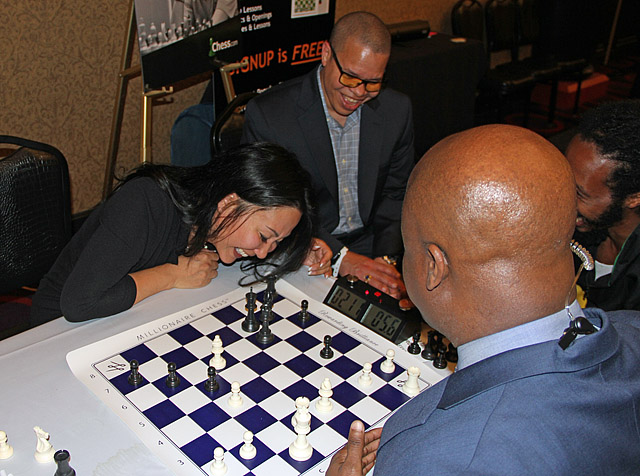
…and got a kick out of trying to flag us!
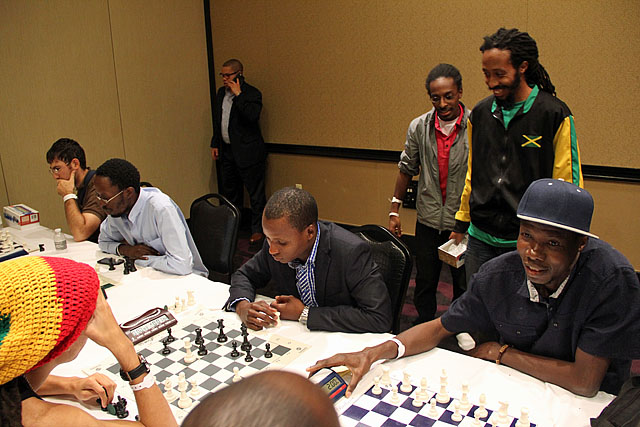
Pan-Africanism at work! FM Harold Wanyama (Uganda), IM Providence Oatlhotse (Botswana) and IM Bunmi Olape (Nigeria) playing blitz while Dominique Myers (USA) and Malaku Lorne (Jamaica) look on. Oatlhotse is playing IM Kassa Korley (Denmark/USA) and Olape is playing Mario Marshall (Jamaica/USA).

CLICK to see larger images. Hover to get descriptions.
All photos by Daaim Shabazz (unless otherwise stated).

While I will not give a letter grade on this event, there were plenty of comments pertaining to the tournament that deserved mention. I congratulated Amy on a job well done, but the perfectionist in her felt that it was not up to her standards.
The five areas of focus are…
-
Tournament Management… A lot of effort went into making MC2 into a world-class event. Perhaps there was not the same amount of publicity, but it yielded an increase of approximately 40-50 players. The idea of 50 GMs from 50 countries had a nice ring although some of the players withdrew for various reasons. Nevertheless, the organization was credible on the front end.

Ashley was proactive in dealing with first round issues.
Everything went smoothly until it was time to make the first pairing. Apparently, an old spreadsheet was used to make the pairing. This included players who had withdrawn and excluded players who had registered on the later deadlines. What occurred was a nightmare. Many players were simply not paired. Others complained that the pairings were not correct. Finally, the first round showed a number of forfeits awarded to titled players. This means those seeking norms would be affected. This problem would come back to haunt the MC team.
While the onus was on the MC organization to ensure a smooth tournament, some of the criticisms was unwarranted and unfair. Particularly as it pertained to people shouting at staff and at Amy Lee, the woman who made this tournament possible and is investing her own money. Yes…. that Amy Lee. I asked her who was this person who shouted at her, but she didn’t know who it was.
Amy was in tears and ended up seeking medical attention due to a bleeding ulcer from the stress. How dare we? Is this how we treat our supporters? This was my worst moment of the tournament and personally had to reassure her. It nearly swore her off of any more MC tournaments. Amy describes the impact on her in her own reflections piece.

The McShane-Nakamura controversy resulted in feverish calls
around the globe to various arbiters.Apart from the tournament snafus with pairings, lateness of some rounds and the confusing tiebreak format, the tournament ran well in other areas. The security was smooth. In fact, I had been bypassing the screening with my press pass, but was stopped when it was discovered that I had both a press and player pass. This meant I would have to be checked. It was a good catch and I was not upset at all. The security guard spoke to Maurice Ashley and my “double status” was verified.

I loved this innovation…
…RFID input of your game through the wristband.
When they got it to work, it’s easy as 1-2-3.
I believe that given the obstacles, the tournament did as much as it could do in real-time and handled problems best they could. Was it always the most convenient to players? Of course not. Was it disappointing to see so many forfeits? Of course. However, putting on such an event will take a stronger team to avoid some of these issues. The load has to be taken off of Maurice and Amy and there need to be someone managing the operation.
-
Tournament Decorum… This has to get an A-. The classy appearance of the lobby and the decorations of the tournament hall were clearly winners. Missing were decorations for the last two rounds of the Open Section, but the Millionaire Monday room was absolutely stunning.

The lobby was wide and made a great place for socializing… and blitz!

FM Mike Klein of chess.com was doing double duty.

Nice eh?
While the water servers were not part of the decorum, they added to the class of the event. It was certainly quite a symbol of customer service. Purple chosen as a brand for Millionaire Chess could not have been a better color. It exudes class, royalty and sets a positive tone. The world champion banners were again a nice addition and Amy’s suggestion of including the women’s champions was a stroke of genius.
-
Fun Factor… There was an opening pool party which seemed to be quite a success… except the pool was not available. However, the photos seem to convey that everyone enjoyed the opportunity to unwind before the event. Blitz battles were all over the place! The breakfast was again a good touch. MC added another breakfast for the second schedule.
Swagger on red carpet.
Photo by David Llada.The red carpet was a hit once again. David Llada took fantastic shots and every seem to enjoy immortalizing the moment. There was some photos that attracted more attention than others, most notably this photo! The confessional booth was also a great addition as many players had a lot of fun saying hello to their family and friend, talking about their games and sometimes just acting silly. Great stuff!
The best-dressed contest is an interesting but in my view still a bit flawed. It seems inconceivable that water girls roaming around focusing on serving water can judge all players when everyone is sitting. Of course, it is not a formal contest, but there is money on the line. It is a great idea going with the “millionaire” theme, but needs tweaking. Perhaps it would be good to post photos of the people who won each day!
The “Millionaire Square” game show was great fun. However, the game had its snags such as players repeatedly missing the questions. The question were not difficult, but the answers were required in 10 seconds. I was able to score many of them, but of course had no pressure on me.
Millionaire Chess Square Gameshow
CLICK to see larger images. Hover to get descriptions.
All photos by Daaim Shabazz (unless otherwise stated).The game show winner P.P. Prachura got a chance to pick one square from 64 to win $1,000,000. After some thought and urging from audience, he picked c4 (after his favorite English Opening). What was the answer? It was… b1! Nevertheless, he got a all-expense paid trip to MC3.

Photo by Mike Klein.
-
Tournament regulations and prizes… Many people were not happy with the quickened time controls in the class section. For me, I was in time trouble in almost each round, but I am also out of form. There were several people asking about the necessity of going from 40/120 to 40/90. Huge difference.
The prizes were not 50-deep as MC1, but they were more lucrative in the open section (total of 30 prizes)… 20 prizes in 2200, 2000, 1800 and 28 for under-1600. One will have to look at the numbers to see if that prize structure will provide enough incentive given the expenses. However, there were many special prizes added.
Lastly, It is not certain why the time of the round changed from the first day to the next. This is usually reserved for the last day. Nevertheless, times of the rounds were posted in the agenda. While it is up to the players to know the schedule, there were a couple of high-profile forfeits. Gata Kamsky was such victim and Vita Kryvoruchko was another.
As for regulations, the no draw before move 30, fell on its face in round seven during the McShane-Nakamura battle. Both players repeated move three times and played a total of nine moves. It created quite a stir and caused the arbiters to scramble for the FIDE Handbook. After nearly two hours (97 minutes) of deliberation and consultation with FIDE International Arbiters, the draw was upheld.
Some suggested a disincentive of draws by reduction of prizes for any game lasting under the 30-move limit. Not sure how practical that would be. It was quite a risk for Nakamura to agree to a draw and it almost cost him a shot at $100,000. GM David Smerdon wrote an essay on this, but not everyone is in agreement. It was a calculated risk and Nakamura guessed right. So what can be done about the draws?
-
Media Coverage… The broadcasts were the highlights of the event. Despite of the outages of the website early on, there was coverage of top boards of all five sections on the main broadcasts. Fans were typically satisfied with the video camerawork, but there were a few jokes about Robert Hess’s superlatives and Lawrence Trent’s puns.
Stacey Moore was of David Llada’s favorite subjects.
One of the problems with the media schedule is that on Millionaire Monday there was no coverage of the Open section which featured Fabiano Caruana, Wesley So, Luke McShane and Gata Kamsky. I visited the room several times and it appeared to be a regular tournament without the MC panache.
MC’s tournament website coverage needed work since daily reports fell behind. In my experience in covering tournaments, this is the first thing that is overlooked by the organizing body. Unfortunately, very few websites gave the tournament the coverage it deserved. I took and posted lots of photos each round, but my reports ran late since I was competing in the tournament and finishing games late. Mike Klein of chess.com ran daily reports for most of the rounds.
David Llada was photographer par excellence; however, he had his favorite subjects. Some of his subjects were photographed rather frequently. Not that I blame him, but he took a lot of pictures of Stacey Moore (who performs in Las Vegas) and Mehrnaz Salem, who is reigning Miss Asia and Miss Iran. There was even a tweet put out to find out Moore’s name.
Synopsis… Neither Amy nor Maurice were 100% pleased with their performance. However, the tournament was largely a success. They did not announce the next one, but it will not return to Vegas. The Planet Hollywood venue was a good start and helped to set the tone for an exclusive event. There are still the naysayers, but certainly MC is creating new ideas.

The original home of Millionaire Chess!
I enjoyed the event overall, but did not appreciate the rancor aimed at Amy. She is making quite an investment and she chose chess. So whenever you talk to Amy, please show some respect! This woman has a pure heart and has even won over the worst of “haters”. It remains to be seen what will become of MC, or whether there will be a tournament. I believe the brand is strong, but help is needed!

GM Maurice Ashley with Adia Onyango and yours truly.
Those criticizing Maurice and somehow believe he is doing all of this unpaid hard work for self-promotion knows nothing about his career. For more than ten years, he has had a vision to take chess to the next level. For thirty years, he has been involved in practically every aspect of chess… except as a politician. Now he has built a chess company. Should he benefit from his hard work and the ultimate success of MC? Of course. Should he continue to do this for free? Of course not.
Suggestions… I would suggest bringing back the phone app, at a minimum. The cell phone is how everyone is accessing information these days and it would put MC firmly at the cutting edge of tournaments. It would make getting pairings so much easier. The app from MC1 was such a wonderful productivity tool. Bill Goichberg is using the text message option for his tournaments.
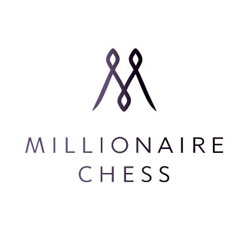
The massage option was a great value, but was not available due to low demand at MC1. I could’ve used this! Maybe we should have the massage chairs closer to where the player traffic is. Demand would soar. There were grumblings about the faster time control. There is quite a difference between 40/120 and 40/90. If it is 40/90 next year, I may play in Open section where you get 40/120 and nine rounds of chess! Look out! 🙂
Of course small aesthetic touches like the water service and the purple runners on the tables are lovely. The new venue will have its own set of challenges, but the structure is already intact. The MC company has already disseminated a questionnaire and are surveying various price points and locations for the next tournament. In my view, resorting back to a $500,000 tournament won’t do.
MC supporter Jones Murphy has suggested an online option (at selected locations) that would allow players to compete without having to shoulder heavy travel and hotel expenses. This would certainly be an incentive, but there would be a number of logistical and technical issues to consider. There are certainly a number of options, but what is paramount is the pursuit of sponsorship.
Help us keep improving MC. Fill out our very short survey here: https://t.co/D1gj3GHDfF. Pretty please.
— Millionaire Chess (@HighStakesChess) October 25, 2015
The chess community should heap effusive praise onto Amy and Maurice for their effort. While not perfect, there were great takeaways from the event and certainly lessons learned. GM Maurice Ashley continues to be a lead innovator in chess and is not afraid to try new ideas. This means MC3 will be stronger… if it should happen.
It will only happen if there is a grassroots support. No longer can you watch from the sidelines and expect chess to have its day in the spotlight. The current investment model is unsustainable and if another model is not found, we can go back to playing in weekend tournaments where the total prize fund may be $2,000. Let’s ride the wave of this chess renaissance. Let’s make MC3 happen!

THANKS AMY FOR SUPPORTING CHESS!
* * *
CONTACT: MILLIONAIRE CHESS
email address: contact@millionairechess.com
official website: https://millionairechess.com/
Twitter: https://twitter.com/HighStakesChess
Facebook: https://www.facebook.com/millionairechess
YouTube: https://www.youtube.com/MillionaireChess
Drum Coverage: https://www.thechessdrum.net/





























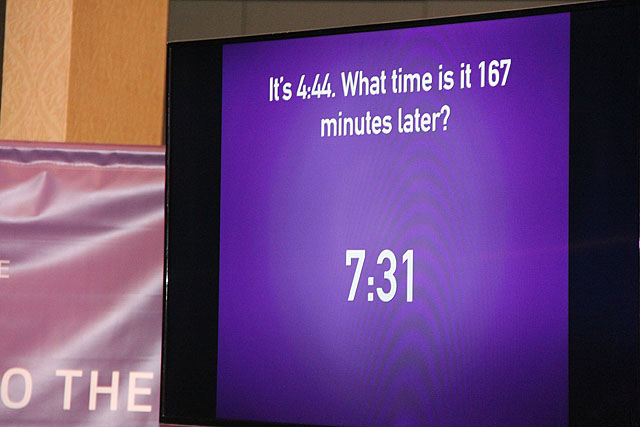

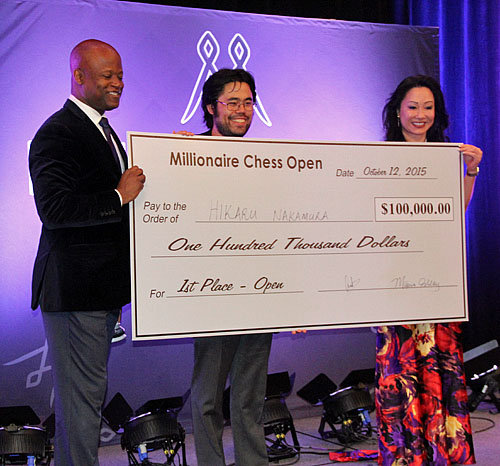

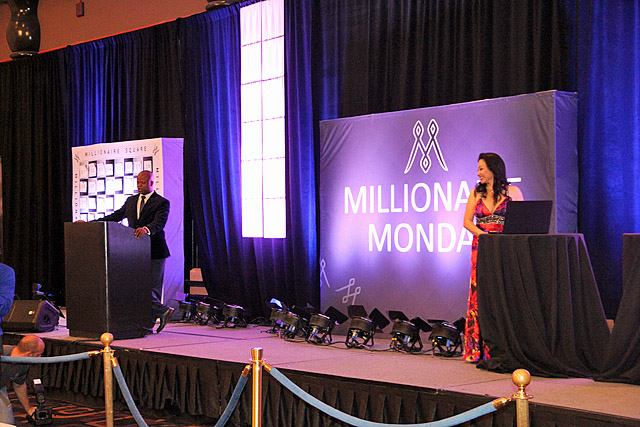

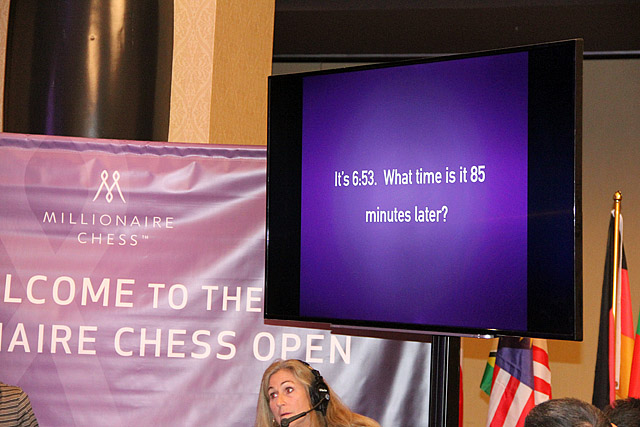
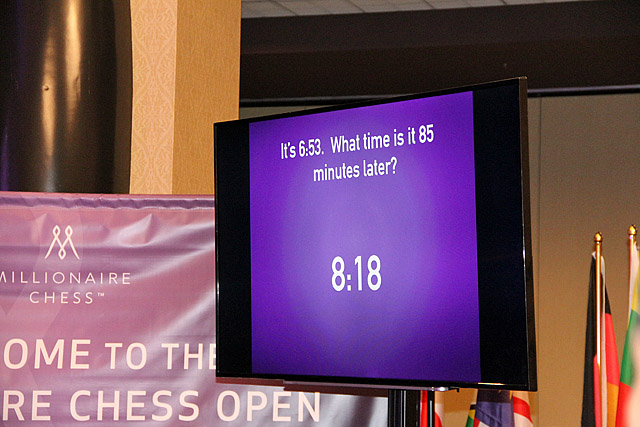





Chessdrummers whats the highest category event a person of african descent has ever won in one of theses traditional events? It looks like ya all had fun! lol
I’m very disappointed to hear about the horrific treatment of Amy on the first day in response to the pairing problems in the first round. She did not deserve that. I, too, was upset in the first round because I was personally affected by the pairing problems, but I would never be shouting at Amy (or anyone else) for that. It’s hard to pull off an event of this scale without any problems, and I think that Maurice and Amy should be commended and appreciated for the two MC events they have put together so far and all they have done to promote and elevate chess! The MCO is the most exciting and anticipated chess event each year for me, and I really hope there is an MC#3!!
I must disagree with you, Daaim: I believe that MC must reduce its prize fund to around $500,000 in order to reduce its entry fee and attract enough entrants. A $1000+ entry fee is simply too much for 98% of chess players, regardless of the size of the prize fund, whereas a $500-$600 entry fee would be considered a reasonable expense by many chess players for such a rich and splendid tournament!
You need sponsors. Such a tournament is not sustainable if you rely on entries. You can reduce the fee and still have the million-dollar prize fund. We have not been able to secure sponsors. With all the chess players in high positions, you’d think we could.
Millionaire Chess is already a strong brand. “Half-a-Million Chess” simply doesn’t have the same ring. 🙂
I understand that sponsors are necessary. That is something I am personally trying to help MC with. But I believe part of the solution, in making the MC tournaments financially viable, is also significantly reducing the entry fee (which still must be a source of revenues for MC tournaments). “Half-a-Million Chess” doesn’t have the same ring, I agree, but I think that a $500,000 prize fund (even with sponsors — unless these sponsors are extremely generous — I don’t believe that a million-dollar prize fund is sustainable) is still very attractive to almost all players and higher than that of any other open tournament! And I’ve suggested having at least TWO MC Opens each year (perhaps one in Europe and one in the U.S.), each with a prize fund of roughly $500,000, so they can still give away a million dollars a year!
Darren,
Looking back now … lowering the entry fee to $499 did not bring higher numbers. In fact, there were just over 400 compared to 550 at $1000+. It is hard to understand.